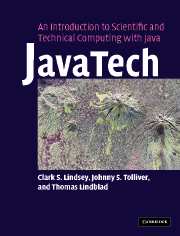Book contents
22 - The Java Native Interface (JNI)
Published online by Cambridge University Press: 08 January 2010
Summary
Introduction
Chapter 20 developed a complete client/server application in which both the client code and the server-side code were implemented completely in Java. Pure Java on the client side is desirable for many reasons – platform portability, rich user interface, object-oriented programming environment, ability to run as an application, an applet or a Java Web Start application, etc. For many of the same reasons, a pure Java server offers obvious advantages too. However, for some calculation-intensive processing tasks, particularly if legacy code in another language already exists, it can be advantageous for a Java program to gain access to code written in another language such as C or Fortran.
Java permits calls to code written in languages other than Java. Such external languages are referred to as “native” languages, and the API for accessing them is called the Java Native Interface, or JNI [1]. The decision to use JNI should be made with great care. JNI is designed for use when it is necessary to take advantage of platform-specific functionality that is not available within the Java Virtual Machine. There are two key concepts in that previous sentence – necessary and platform-specific functionality. To utilize platform-specific functionality via JNI obviously removes Java's platform portability. In fact, any use of JNI at all renders a Java application no longer platform portable since the Java application requires a native shared object library for each platform to which it is targeted.
- Type
- Chapter
- Information
- Publisher: Cambridge University PressPrint publication year: 2005
References
- 1
- Cited by



